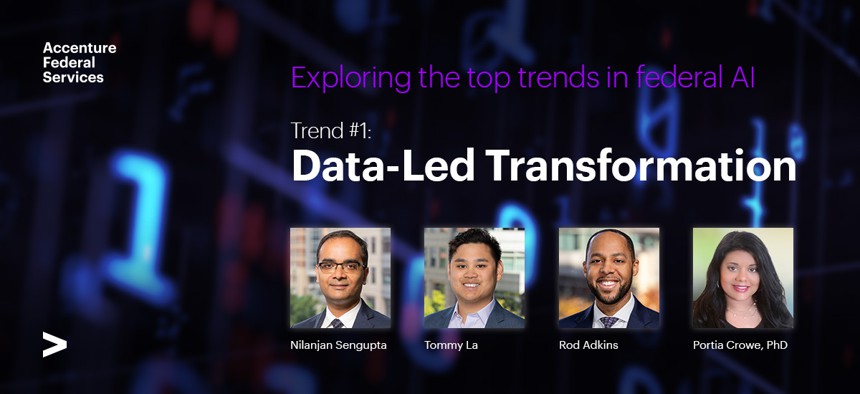sponsor content What's this?

Data-led transformation: Minimize sprawl, maximize value
Data-led transformation strategies can help federal agencies reign in data sprawl and better harness their data’s full potential.
Presented by
Accenture Federal Services

The race is on to transform data into increasing enterprise value. According to research firm IDC, the “global datasphere” is projected to double over the next four years, with enterprises expected to account for 70% of this data by 2026. And Fortune 1 — the U.S. federal government — produces arguably the most valuable data with significant potential to impact nearly every facet of modern life.
At the same time, federal leaders also face new demands to get this data under control or risk critical exposure from unmitigated data sprawl. For example, technology ecosystems are increasingly formless, with no clear boundary between the application someone is using and where its data may be sourced from or stored. Structure is needed here to drive value, and ensure compliance, protect privacy, defeat cyber criminals and so much more.
Given these shifts, it’s more important than ever for the federal government to gain control over its data. Data is the foundation upon which the federal government’s digital future is being built; if that data is largely unorganized, siloed, or inaccessible, agencies will never be able to realize its full value to support advanced decision-making and mission execution.
This is the imperative behind emerging data-led transformation strategies, approaches that position data as a key asset throughout enterprise strategy, execution, and operations. By redesigning business and technology models to harness the full potential of data, agencies can reign in sprawl, better leverage data at speed and scale, and ultimately uncover deeper, more integrated insights.
Already, most commercial leaders understand the importance of data-led transformation. Research shows that:
- 78% of chief data officers (CDOs) say driving value creation is one of their most critical responsibilities.
- Yet, 55% of companies still have a mostly manual approach to discovering data within their enterprise, and only 28% have a strategy in place to take advantage of it.
- 81% of organizations lack an enterprise data strategy to fully capitalize on their data assets.
- But by 2024, 50% of new system deployments in the cloud will be based on a cohesive cloud data ecosystem, rather than on manually integrated point solutions, according to Gartner®.[i]
With data-led transformation, agencies can better meet complex mission needs while addressing federal directives, including the 2018 Foundations for Evidence-Based Policymaking Act, which requires the federal government to modernize its data management practices.
Based on our work with federal agencies, we have found it critical to approach your data-led transformation as a series of three phases:
1. Focus on a data-led strategy from the start.
Before you can unlock your data’s most valuable insights, you need to take stock of where you are in terms of your current capabilities and then think ahead. At Accenture Federal Services, we use a straightforward framework. First, look in the mirror: Understand what data you have, what data you want to use, for what purposes, and what related skill sets you’ll need to manage that data. Then, look out the window: Think about what other organizations you admire and what approaches they’re using that most inspire you. Finally, look into the crystal ball: Align on your North Star and what tools are available to help you get there. Some basic questions you might consider here include: What is your mission? Who are your people? What’s the customer experience or employee experience that you’re trying to influence through your transformation? Be aspirational.
Next, get tactical: Consider what you need to do to prepare your data in terms of tagging and labeling. Often, an upfront investment can seem quite significant because of how large the data sets and assets are within the federal government, but that investment is worth it over time when you consider your North Star. Data-led transformation, when done effectively, is an ever-living, integrated process that creates ongoing value.
2. Promote a data-driven culture.
Remember that data-led transformation is not just a new data management policy from the IT department. It’s an organizational and cultural shift that needs to permeate all different elements of your enterprise, from how people are trained to how infrastructure is upgraded to how security is managed.
For example, the current convergence of many different vendors and cloud ecosystems requires not just attention to data sprawl; organizations must also ensure they have the required skill sets across both traditional and new technologies.
And as data and teams spread across multi-cloud and hybrid architectures, agencies will face new challenges in identifying data risks across the enterprise. To address this, they will continually need to refine their risk assessment strategies, and data security governance policies.
While digital transformations are often led by the CIO, they are full business transformations—so it’s essential that all stakeholders are aligned with the mission.
3. Execute at scale.
Once you’ve articulated a clear strategy for your data-led transformation and built a data-driven culture across your enterprise, it’s time to execute at scale with the right talent and by adopting the right technology stack. What does this look like? Recently, the U.S. Department of Education, which manages a $1.6 trillion student loan portfolio, underwent a significant data-led transformation to build a more seamless student borrower experience—for more than 45 million student borrowers.
As a result of that transformation work, when borrowers now apply for federal student aid, it’s possible to track in one place who they spoke to, what schools they applied for, what schools they went to, whether or not they dropped out and then, subsequently, whether or not they paid their loans successfully. This kind of cohesive, data-led experience enables the DOE to drive new mission outcomes and improve student borrowers’ experiences.
In all areas of the government, one thing is certain: Agencies have a lot of data and now it’s time to make the most of it.
Data-led transformation is essential for any federal agency that wants to build trust, spark innovation, and add greater value. Without having a better understanding of your data, and a future-looking plan for how to use it, it will become impossible to meet everchanging, increasingly complex mission needs. Putting the mission first means putting data first.
This is part of a series by Accenture Federal Services on the top four trends building the future of federal AI. Read our overview to see all the trends and stay tuned for more deep dives on each in the coming weeks.
Authors:
- Rod Adkins | Lead Technical Advisor | LinkedIn
- Portia Crowe, Ph.D.| Chief Data Scientist, Defense and Applied Intelligence | LinkedIn
- Tommy La | Managing Director, Applied Intelligence | LinkedIn
- Nilanjan Sengupta | Managing Director and Chief Technology Officer, Applied Intelligence | LinkedIn
[i] Gartner, The Impact of Data Warehouse Automation, Henry Cook, 30 December 2021.
This content is made possible by our sponsor, Accenture. The editorial staff of GovExec was not involved in its preparation.
NEXT STORY: 2022 Experience Makers Government Forum TV Episode 2






